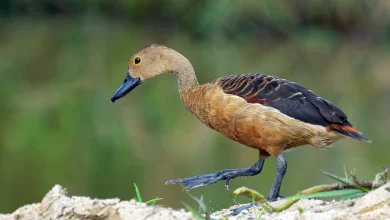The bird often referred to as the “camel bird” is more commonly known by its scientific name, Rhea, and belongs to the family Rheidae. This large, flightless bird, native to South America, is a member of the order Palaeognathae, which also includes ostriches, emus, and kiwis. The term “camel bird” is a colloquialism used in some regions to describe this bird due to its somewhat peculiar and distinctive appearance.
Rheas are divided into two main species: the Greater Rhea (Rhea americana) and the Lesser Rhea (Rhea pennata). The Greater Rhea, also known as the American Rhea, is found predominantly in the open and semi-arid regions of eastern and central South America, including countries such as Brazil, Argentina, Paraguay, and Uruguay. The Lesser Rhea, on the other hand, is primarily located in the Andean regions of South America, including northern Chile, Peru, Bolivia, and northwestern Argentina.
The physical appearance of the Rhea is striking and somewhat reminiscent of other large flightless birds. Rheas have long, slender legs adapted for running at high speeds, a necessity for escaping predators in their native habitats. Their plumage is generally soft and loosely structured, which gives them a somewhat shaggy appearance. The feathers are typically a combination of grey, brown, and black, aiding in camouflage within their natural environments. The Greater Rhea can reach a height of up to 5.5 feet (1.7 meters) and weigh between 55 to 66 pounds (25 to 30 kilograms), while the Lesser Rhea is slightly smaller, standing up to 4.5 feet (1.4 meters) tall and weighing around 33 to 44 pounds (15 to 20 kilograms).
Rheas, like their relatives the ostriches and emus, have small, vestigial wings that are incapable of flight. Instead, these wings are used for balance and display during mating rituals. Despite their inability to fly, Rheas are exceptionally fast runners, capable of reaching speeds up to 37 miles per hour (60 kilometers per hour). This speed, coupled with their large size, makes them one of the fastest running birds in the world.
In terms of diet, Rheas are omnivorous and have a varied diet that includes plants, seeds, fruits, insects, and small vertebrates. Their foraging behavior is adapted to the different types of vegetation and food sources available in their habitats. They are known to graze on grasses and browse on shrubs, and in times of scarcity, they may consume insects and small animals to meet their nutritional needs. Their digestive system is also adapted to their diet, featuring a large gizzard that aids in grinding up food.
Breeding behavior in Rheas is quite fascinating and differs between the two species. During the breeding season, male Rheas become highly territorial and engage in elaborate courtship displays to attract females. These displays include running in circles, flapping their wings, and making a series of vocalizations. Once a female selects a male, she will lay her eggs in a communal nest that is constructed by the male. The nest is typically a shallow depression in the ground, which the male lines with grass and feathers. The female usually lays a clutch of eggs, with the number varying from 12 to 30 eggs per nest.
After the eggs are laid, the male assumes responsibility for incubating them and protecting the nest from potential threats. The incubation period lasts around 40 days, during which the male remains on the nest almost continuously, leaving only briefly to forage for food. Once the chicks hatch, they are precocial, meaning they are born with their eyes open and are able to walk and feed themselves shortly after emerging from the egg. The male continues to care for and protect the chicks until they are old enough to fend for themselves.
Rheas play an important role in their ecosystems as herbivores and seed dispersers. By consuming a wide variety of plant materials and fruits, they help to facilitate plant regeneration and maintain the health of their habitats. Additionally, their presence in the environment provides a food source for various predators, contributing to the complex web of life in their native regions.
Despite their ecological significance, Rheas face several threats due to habitat loss, hunting, and other human activities. The conversion of their natural habitats into agricultural land and the expansion of human settlements have significantly impacted their populations. In some areas, Rheas are hunted for their meat, feathers, and eggs, which has further contributed to their decline. Conservation efforts are ongoing to protect and preserve these remarkable birds and their habitats. Organizations and wildlife agencies work to promote sustainable land use practices, establish protected areas, and raise awareness about the importance of Rheas in their ecosystems.
In conclusion, the Rhea, often colloquially referred to as the “camel bird,” is a fascinating and unique flightless bird indigenous to South America. Its distinct physical characteristics, behavior, and ecological role make it a remarkable subject of study and an important component of its natural habitat. Efforts to conserve and protect Rheas are crucial to ensuring the continued survival of this remarkable species and maintaining the biodiversity of their native regions.




